Growing basil in your own garden is a rewarding and delicious experience. With a wide variety of basil seeds to choose from, you can create lush greens and enjoy fresh flavors right at home. Whether you prefer to plant basil seeds indoors or outdoors, there are options for every type of gardener. From organic basil seeds to heirloom varieties, you can find the best basil seeds to suit your needs and taste preferences.
Key Takeaways:
- Growing basil in your garden allows you to enjoy fresh flavors and vibrant greens.
- There is a wide variety of basil seeds available, including organic and heirloom options.
- Basil seeds can be planted indoors or outdoors, depending on your preference and growing conditions.
- Choosing the right basil seeds is important for a successful and flavorful harvest.
When it comes to growing basil from seeds, there are several key factors to consider. First, decide whether you want to plant your basil seeds indoors or outdoors. Indoor seed planting allows for year-round cultivation and greater control over growing conditions. Outdoor seed planting, on the other hand, provides the benefit of natural sunlight and a larger growing space.
For those who prefer organic gardening, there are plenty of options for organic basil seeds. Organic seeds are grown without the use of synthetic fertilizers or pesticides, making them a healthier choice for both you and the environment. Look for reputable seed suppliers that offer certified organic basil seeds for your garden.
When selecting basil seeds, consider the specific cultivars that best suit your tastes and growing conditions. Some basil varieties have bold and spicy flavors that are ideal for savory dishes, while others have a mild sweetness that works well in baked goods and desserts. Take into account the size and growth habits of the basil plants, as well as their ornamental qualities, if you want to add visual interest to your garden.
Here are some popular basil cultivars to consider:
Boxwood Basil
The Boxwood basil variety features small leaves that maintain a perfect, shrub-like form even in the heat of summer. It’s an excellent choice for containers, edging, and knot gardens. The strong flavor of Boxwood basil is superb in pesto.
Cinnamon Basil
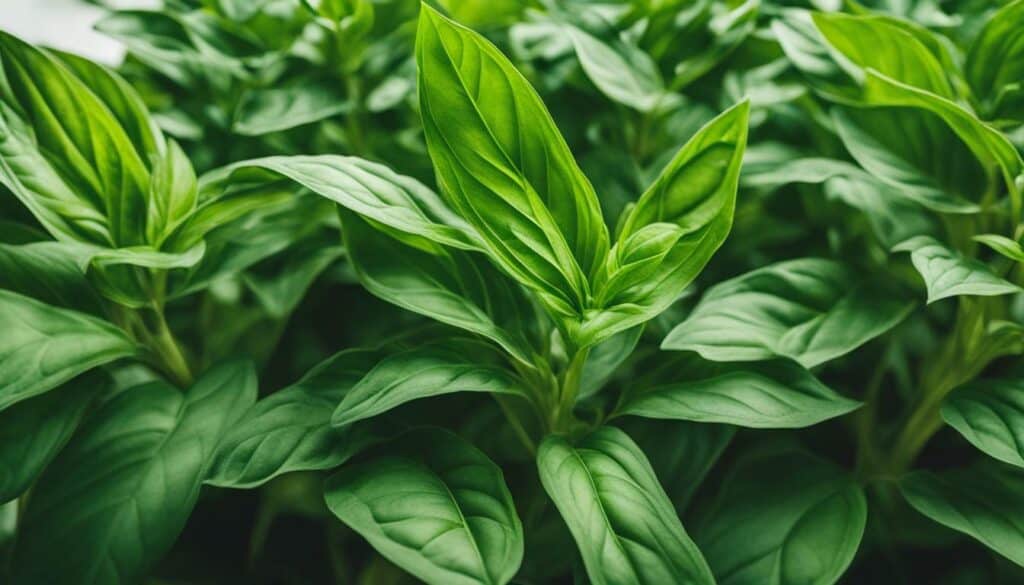
Cinnamon basil is a sweet-flavored cultivar with a distinctive taste reminiscent of cinnamon. It’s perfect for adding flavor to baked goods, jellies, and vinegars. The narrow leaves, dark colored stems, and pretty purple flowers of Cinnamon basil also add visual appeal to your garden.
Dark Opal Basil
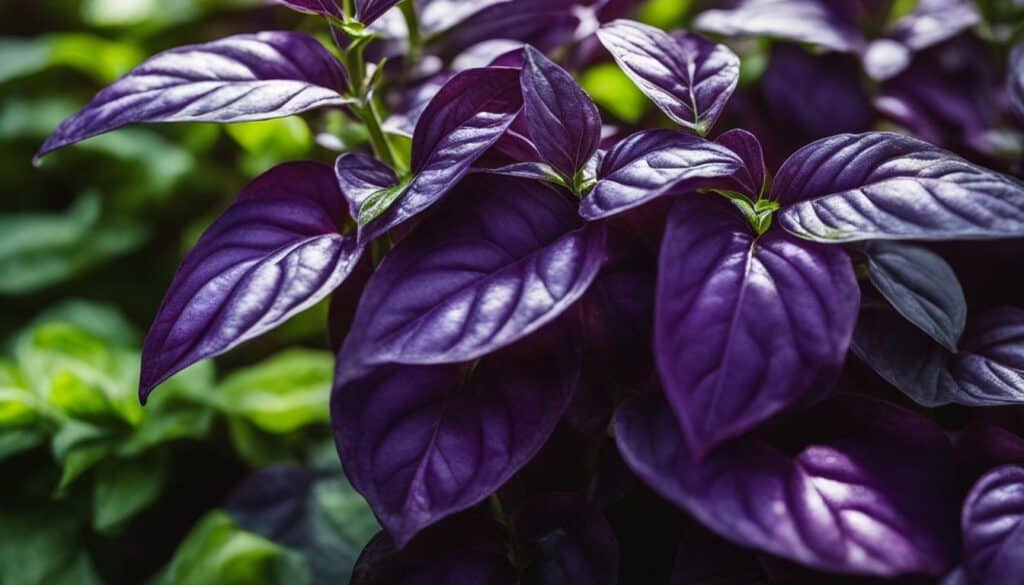
Dark Opal basil has wonderful deep purple leaves and pinky-lilac flowers that give it great ornamental value. The flavor is anise-based with a hint of ginger, making it suitable for both savory and sweet dishes. This variety is delightful in containers, mixed beds, or anywhere you want to attract pollinators.
Emerald Towers Basil
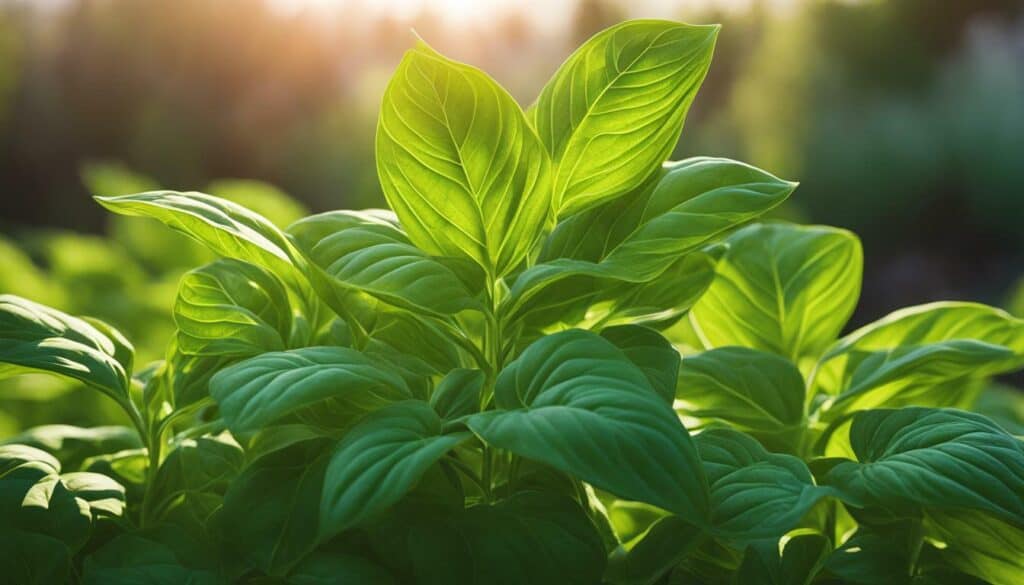
Emerald Towers basil is a tall, multi-branched Genovese type with a tidy columnar habit. It produces an outstanding harvest with a full licorice taste and a scent of spicy cloves. This generous herb is perfect for containers or in-ground gardens, and it can reach a mature height of 24-36 inches with a spread of 8-12 inches.
Genovese Basil
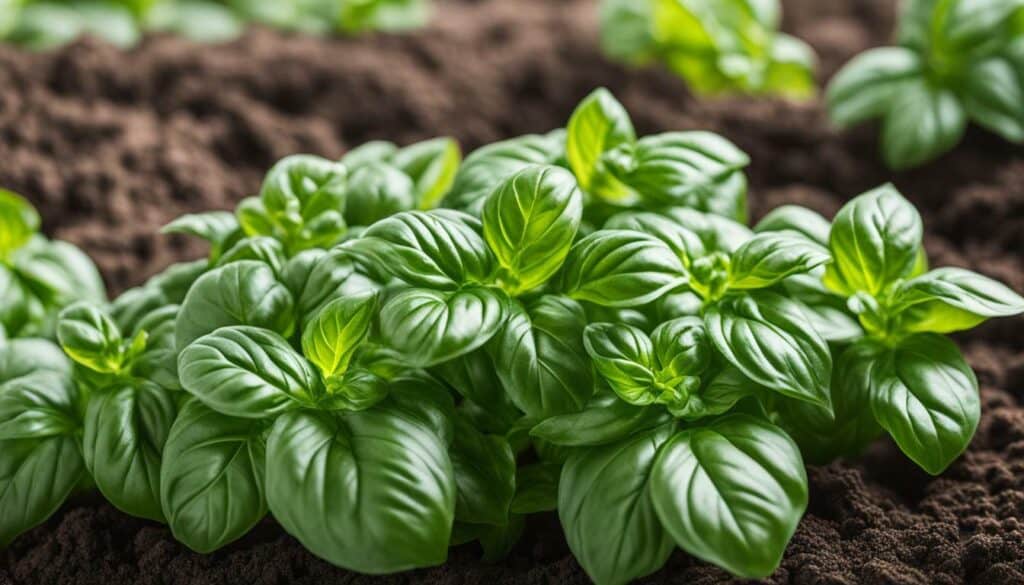
Genovese basil is the traditional heirloom Italian type with a pronounced anise flavor, sweet clove fragrance, and large, lustrous leaves. It’s a must-have for the kitchen garden, perfect for pesto, fresh salads, and all things savory. This cultivar grows to a mature height of 16 inches tall, with a spread of 12 inches.
These are just a few examples of the many basil cultivars available. Explore the different flavors, growth habits, and uses of each variety to find the best basil seeds for your garden. Happy planting!
Why Grow Basil from Seeds?
There are several reasons why growing basil from seeds is a great choice for gardeners. Whether you prefer indoor or outdoor gardening, starting basil from seeds allows you to have full control over the process and ensures that you have the best quality plants.
When you grow basil from seeds, you have the advantage of selecting organic basil seeds, which means you can avoid the use of pesticides and chemicals. This is especially important if you value organic gardening and want to ensure that the herbs you consume are free from harmful substances.
Gardening with basil seeds also gives you the satisfaction of watching the seeds sprout and grow into lush plants. It’s a rewarding experience to witness the transformation from tiny seeds to flourishing basil plants, and it allows you to connect with nature and appreciate the beauty of the growing process.
Another benefit of planting basil seeds is the cost-effectiveness. Buying seeds is usually more affordable than purchasing established plants, and a single packet of basil seeds can yield multiple plants. This is particularly advantageous if you have a large garden or if you enjoy growing basil in different areas of your home.
Basil seeds can be planted both indoors and outdoors, providing flexibility and versatility. Indoor basil seed planting allows you to have fresh herbs year-round, while outdoor basil seed planting gives you the opportunity to enjoy your garden and benefit from natural sunlight and outdoor conditions.
Whether you’re a beginner or an experienced gardener, planting basil seeds is a simple and straightforward process. It’s a great way to start your gardening journey or expand your herb garden with a variety of basil cultivars.
Choosing the Right Basil Seeds
When it comes to choosing the right basil seeds for your garden, quality matters. Opt for top-quality seeds from reputable suppliers to ensure successful germination and robust plant growth. Here are some key factors to consider:
Reputable Suppliers
Look for reputable seed suppliers that have a track record of providing high-quality seeds. Read customer reviews and ratings to gauge the reliability of the supplier. A reputable supplier will offer a wide selection of basil cultivars and provide detailed information about each variety.
Top Quality Seeds
Choose seeds that are fresh and have a high germination rate. High-quality seeds will be plump, uniform in size, and free from damage or discoloration. Avoid seeds that are outdated or past their expiration date, as they may have lower viability.
Heirloom Varieties
If you’re looking for unique and flavorful basil varieties, consider heirloom seeds. Heirloom basil seeds come from plants that have been passed down through generations and are known for their exceptional taste and characteristics. These varieties often have a rich history and offer a diverse range of flavors and aromas.
By selecting the best basil seeds, you’ll set yourself up for a successful and rewarding gardening experience. Remember to follow the planting and care instructions specific to each basil variety to ensure optimal growth and flavor.
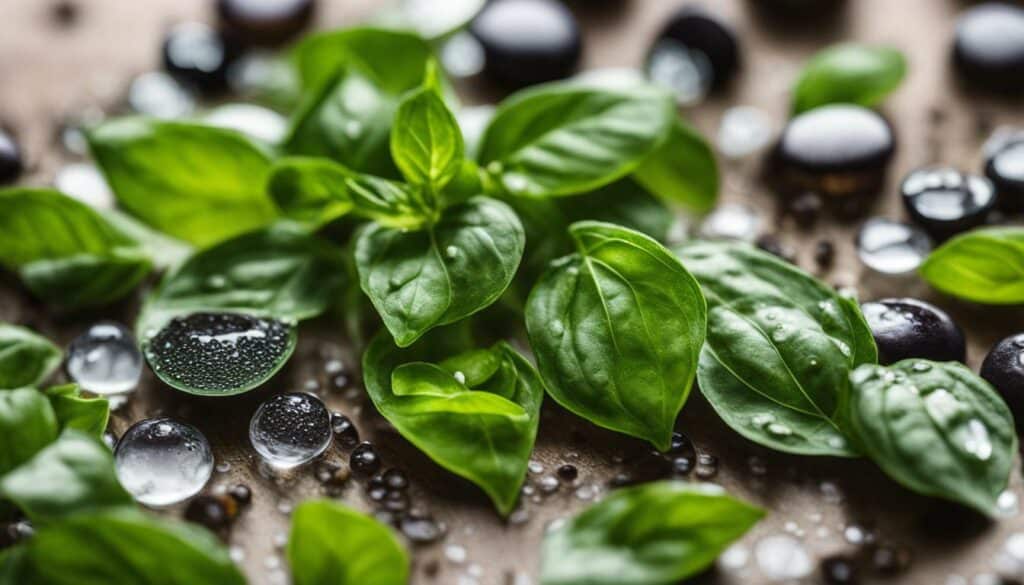
Popular Basil Cultivars for Your Garden
With so many basil cultivars to choose from, it can be overwhelming to decide which ones to grow in your garden. Here are some of the top favorite basil varieties that are sure to thrive in your garden and add a burst of flavor to your culinary creations.
Boxwood Basil
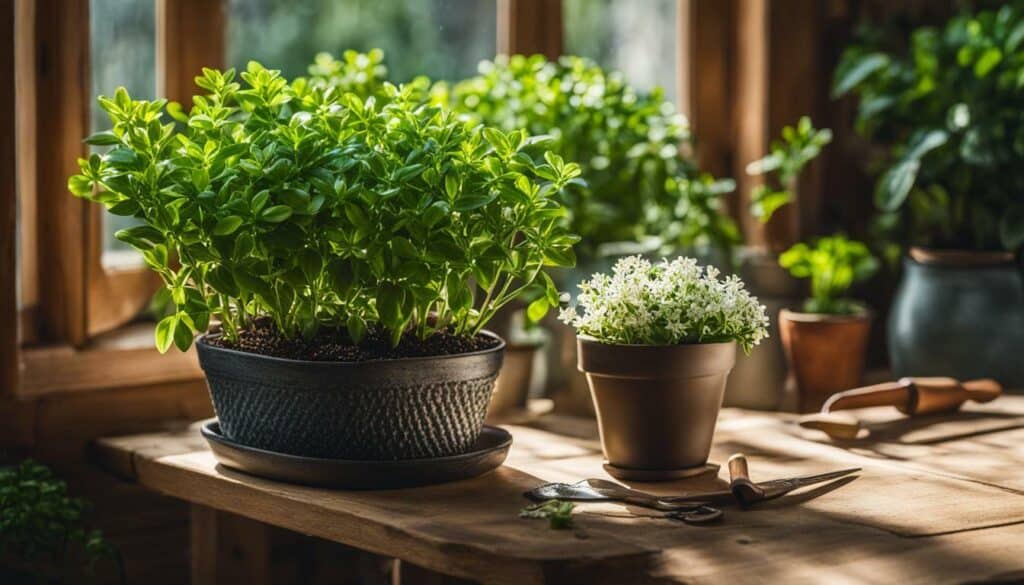
One popular basil cultivar is Boxwood Basil. This variety features small leaves that keep a perfect, shrub-like form even in the heat of summer – just like a boxwood plant. It is wonderful for containers, edging, and knot gardens, and its strong flavor is superb in pesto.
Cinnamon Basil
Another favorite basil cultivar is Cinnamon Basil. This sweet-flavored variety has a distinctive cinnamon taste that’s delicious in baked goods, jellies, and vinegars. It has narrow leaves, dark colored stems, and pretty purple flowers that add great visual appeal to your garden.
Dark Opal Basil
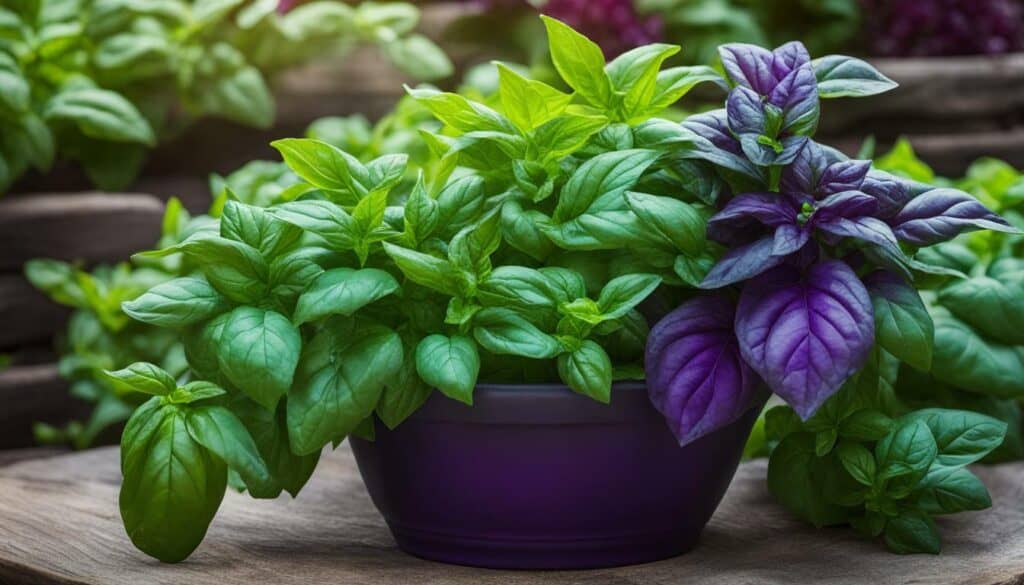
Dark Opal Basil is a basil cultivar with wonderful deep purple leaves and pinky-lilac flowers that give it great ornamental value. It has an anise-based flavor with a hint of ginger, making it suitable for both savory and sweet dishes. This variety is delightful in containers, mixed beds, or anywhere you want to attract pollinators.
Emerald Towers Basil
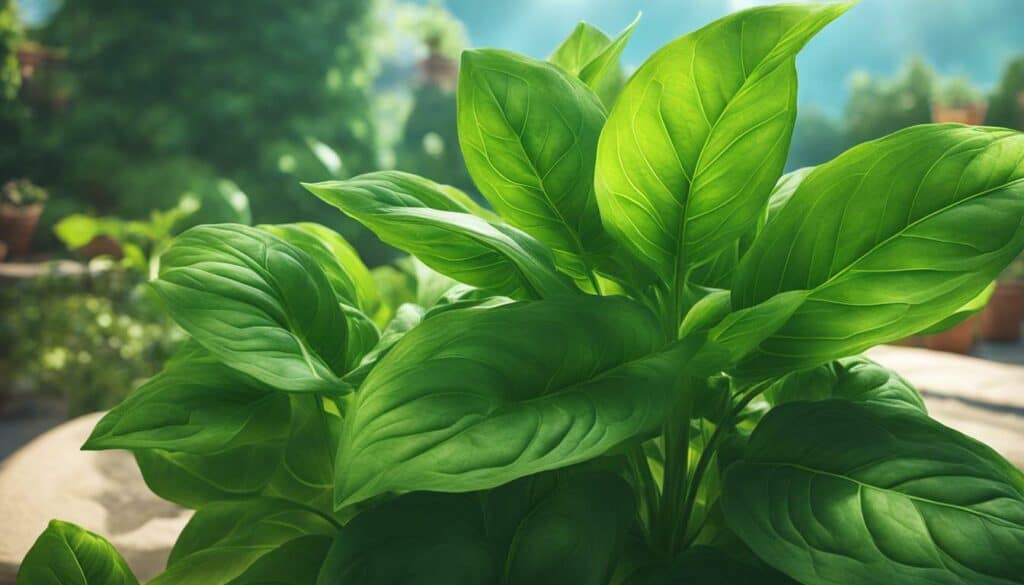
Emerald Towers Basil is a tall, multi-branched Genovese type with a tidy columnar habit that produces an outstanding harvest. It has a full licorice taste and a scent of spicy cloves. This generous herb is perfect for containers or in the ground, and it can reach a mature height of 24-36 inches with a spread of 8-12 inches.
Genovese Basil
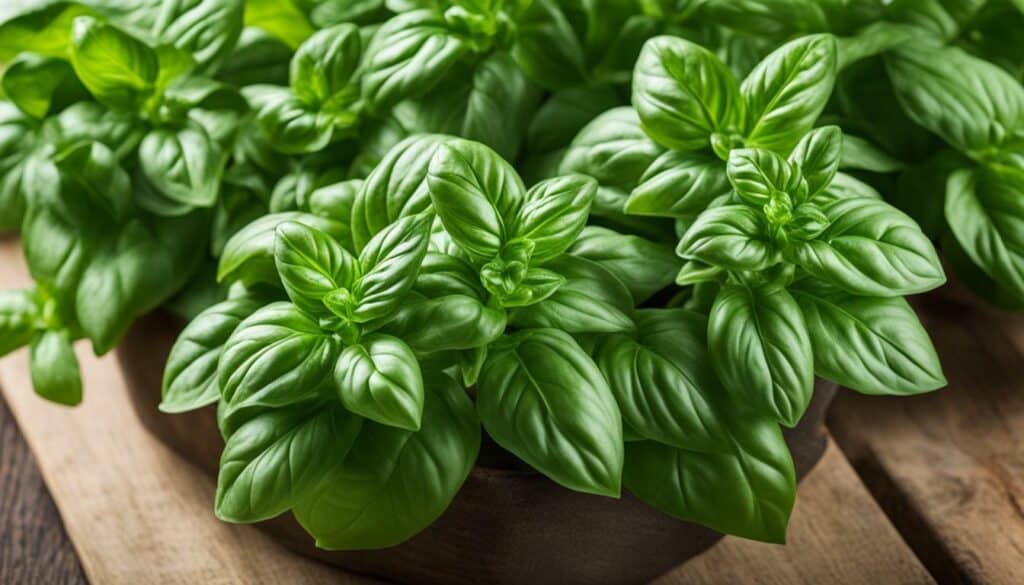
Genovese Basil is the traditional heirloom Italian type with a pronounced anise flavor, sweet clove fragrance, and large, lustrous leaves. It is perfect for pesto, fresh salads, and all things savory. This cultivar grows to a mature height of 16 inches tall, with a spread of 12 inches.
Greek Basil
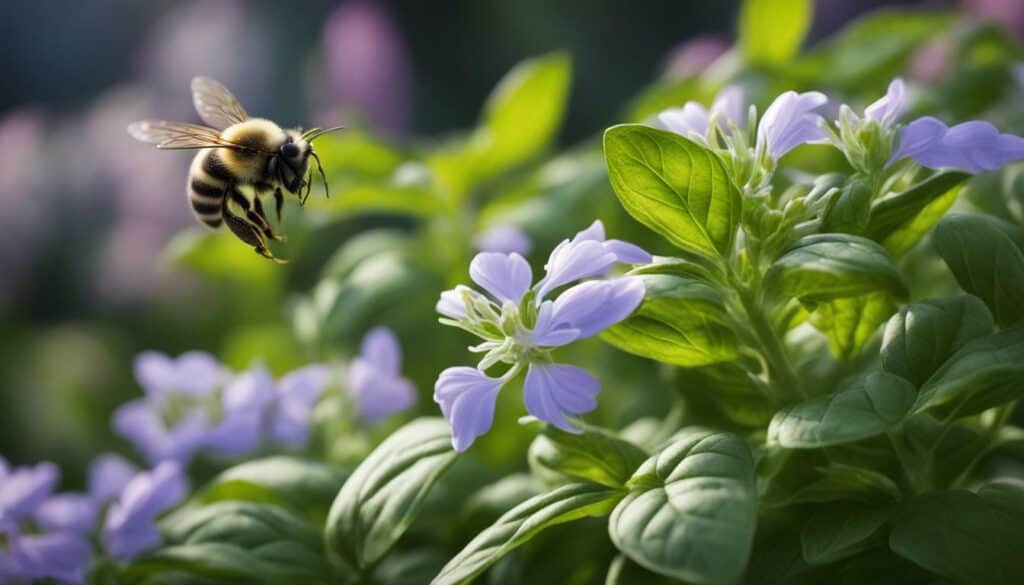
Greek Basil is a compact variety with small leaves, tiny white flowers, and a neat, globular growth habit that makes it attractive in containers, edging, or rockeries. It has a deeply spicy fragrance and strong flavor that’s best used in salad dressings, sauces, soups, and stews. This dwarf variety grows to a mature height of just eight inches, with a similar spread.
Italian Large Leaf Basil
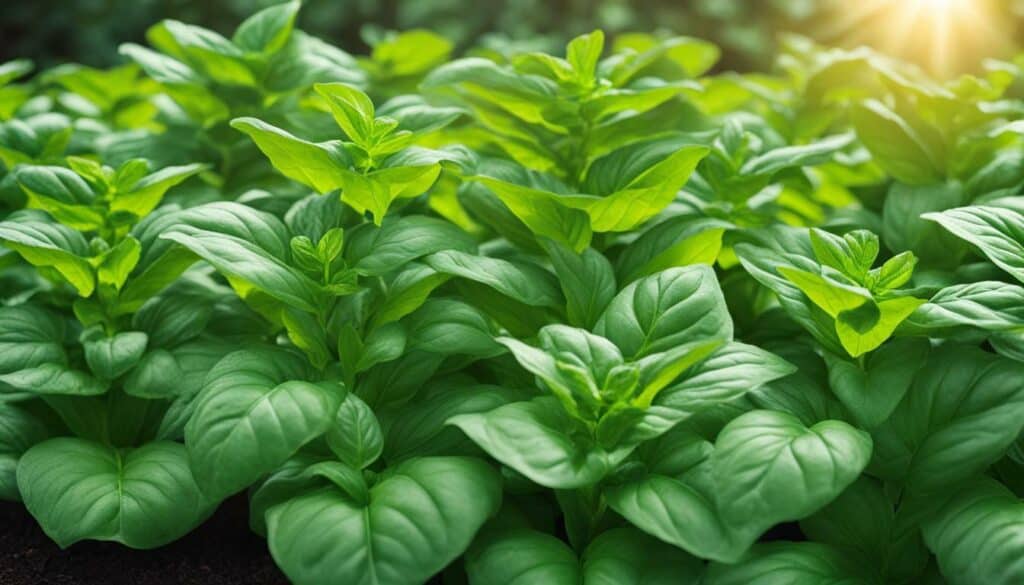
Italian Large Leaf Basil is a classic cultivar with the largest leaves of all basil plants. It has a sweet and mild flavor, making it versatile in the kitchen. This variety grows to a mature height of 24-30 inches, with a 12-inch spread. It can be planted in containers, in a sunny spot in your herb garden, or on a windowsill.
Lemon Basil
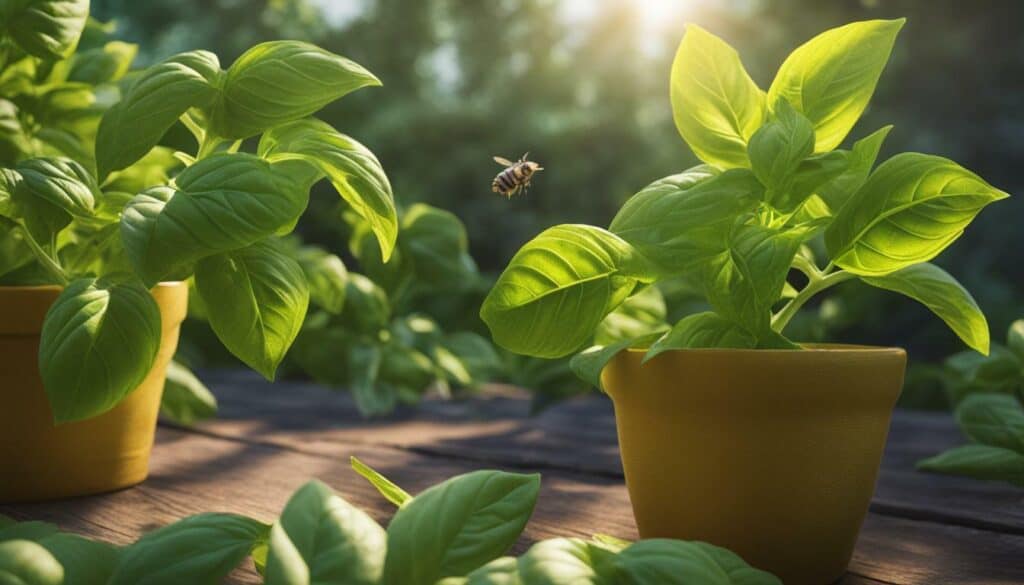
Lemon Basil is a key ingredient in Indonesian cuisine. It is a hybrid variety with a fresh lemon scent and sweet-tart flavor. This cultivar grows to a mature height of 20-24 inches, with a 12-inch spread. Lemon Basil is popular eaten fresh in salads and wraps or incorporated into curries, soups, stews, and stir-fries.
Lime Basil
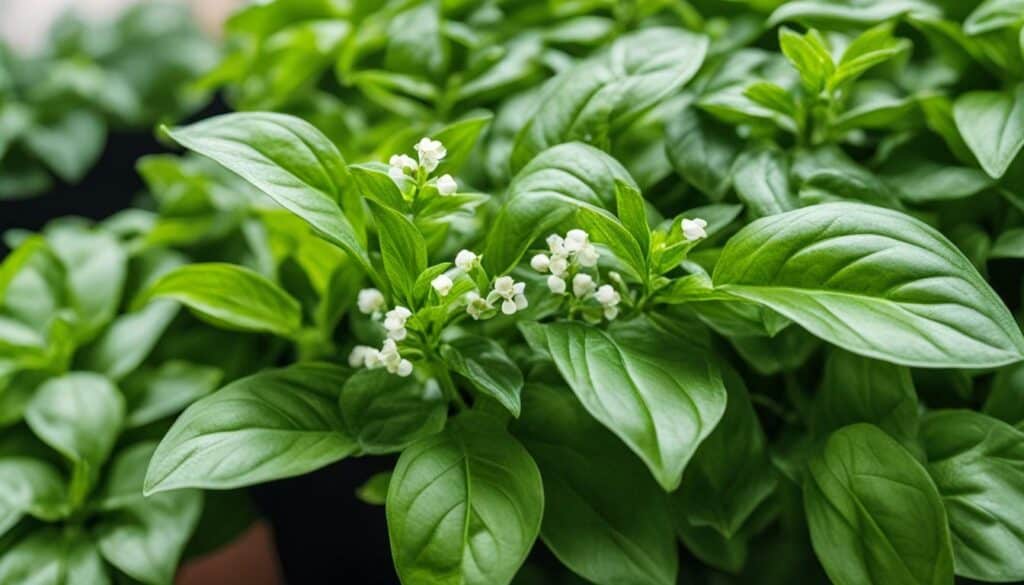
Lime Basil has a light, floral-citrusy flavor and fragrance, making it ideal for adding a touch of zest to beverages, salad dressings, sauces, and desserts. It is a lovely container plant wherever the tangy fragrance can be enjoyed. This cultivar grows to a mature height of 16-24 inches, with a 12-inch spread.
Mammoth Basil
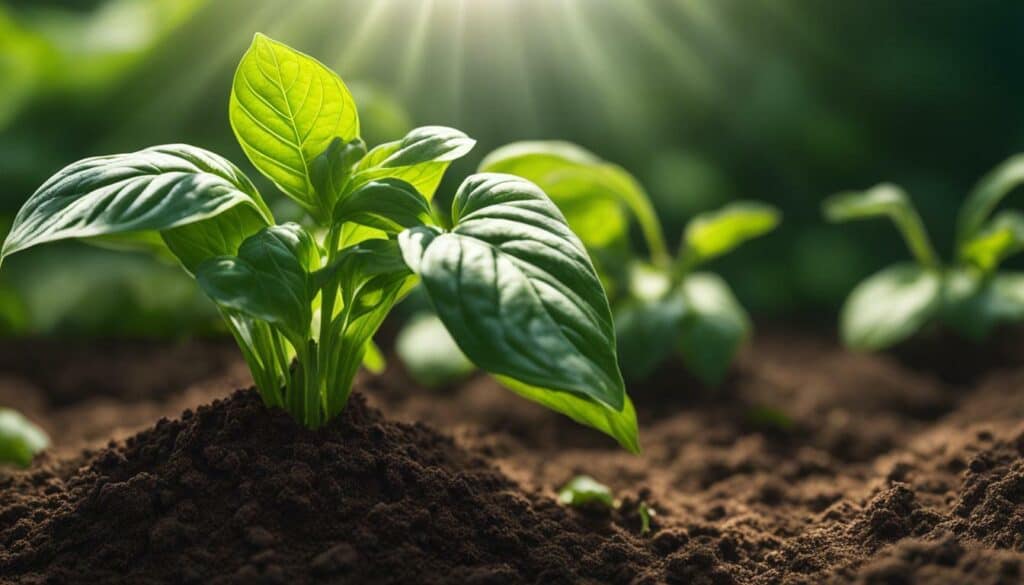
Mammoth Basil, also known as ‘Monstruoso,’ is a lettuce leaf cultivar that features huge savoyed leaves with ruffled edges and uniform growth. It has a spicy clove fragrance and a sweetly pungent flavor similar to Genovese basil, but stronger. Perfect for use in Italian recipes or for pesto, Mammoth Basil grows to a mature height of 16 inches, with a 12-16 inch spread.
Minette Basil
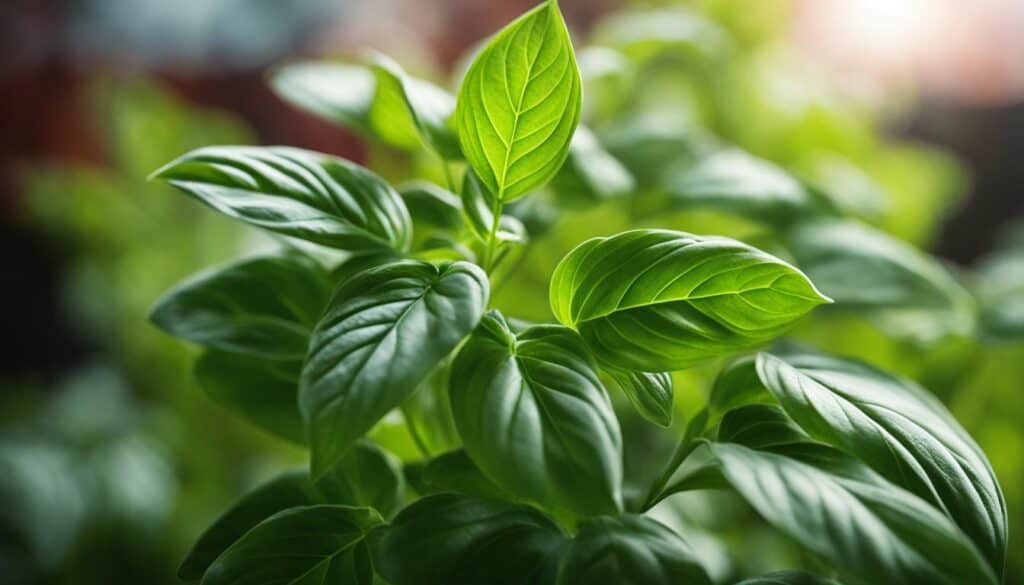
Minette Basil is a compact, small-leaved Greek cultivar with a mounding habit that’s adorable as an edging plant, in containers, or in knot gardens. With a sweet anise flavor and scent of cloves, this variety grows to a mature height of just 10 inches with a comparable spread, and it forms a beautiful spherical shape.
Siam Queen Basil
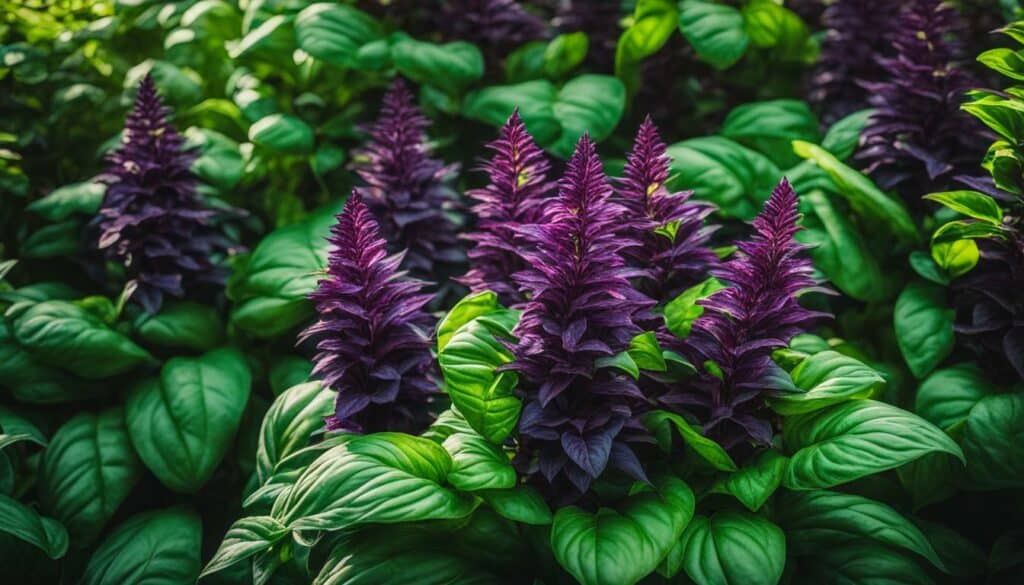
Siam Queen Basil is a Thai variety with a sweet licorice flavor that’s rewarding in the kitchen and as an ornamental. It has lush green leaves and purple stems, and it grows to a mature height of 10-24 inches, with a similar spread. Siam Queen Basil was an All-America Selections Winner in the vegetable category in 1997.
Sweet Basil
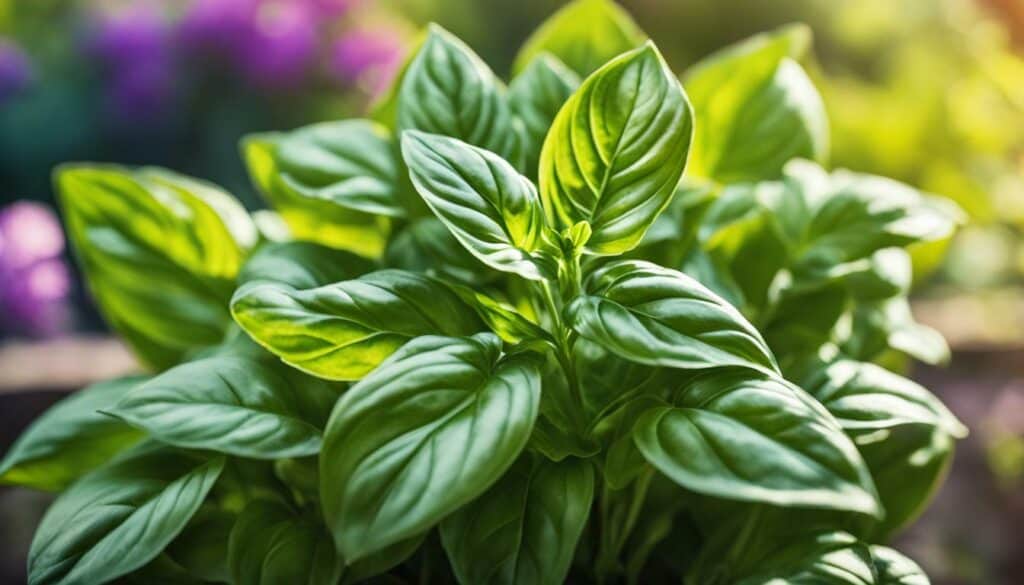
Sweet Basil is the classic basil variety known for its delightful aroma and robust flavor. It is perfect for making pesto, adding to salads, and using in a variety of culinary dishes. This cultivar grows to a mature height of 12-24 inches, with a spread of 12-18 inches.
These are just a few of the many basil cultivars available, each with its own unique flavor and characteristics. Experiment with different varieties to find your favorites and enjoy the fresh, aromatic taste of basil in your garden and kitchen.
The Boxwood Basil: A Delightful Addition to Your Garden
The Boxwood basil variety is a delightful addition to any garden, with its small leaves and shrub-like form that stays neat even in the hottest summer months. This compact variety is known for its exceptional flavor, making it a popular choice for pesto and other savory dishes. Whether you’re growing basil in containers, edging your garden beds, or creating a knot garden, Boxwood basil is sure to add both visual appeal and culinary delight to your garden.
Key Features of Boxwood Basil
Boxwood basil is a compact variety, growing to a mature height of 12 inches with a spread of 12-16 inches. Its small, dense leaves resemble the shape and form of a boxwood plant, hence its name. This variety is perfect for container gardening, edging your garden beds, or creating a knot garden.
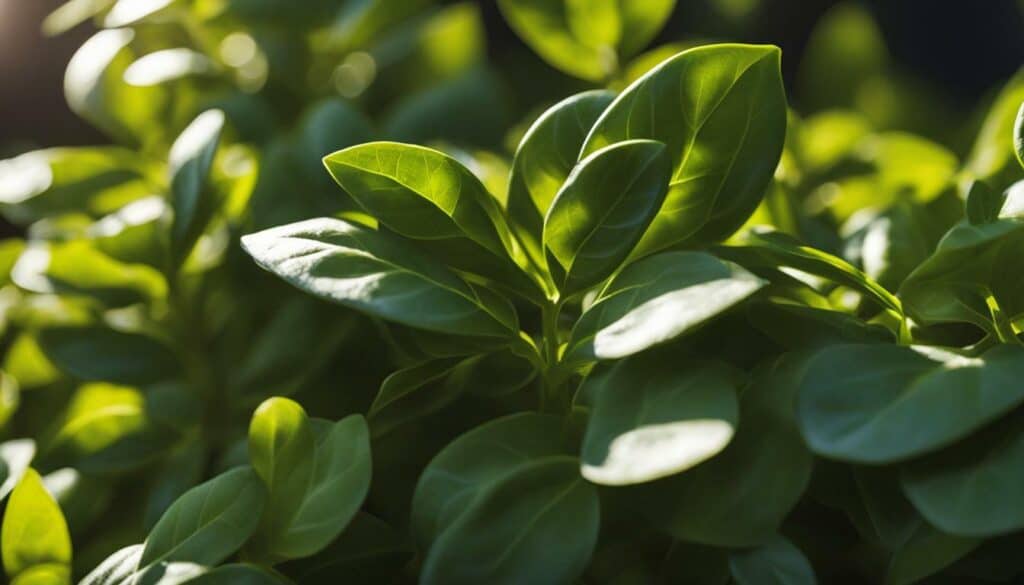
Flavor Profile and Culinary Uses
Boxwood basil is known for its strong and flavorful leaves, making it a favorite for pesto and other savory dishes. Its pungent, peppery taste with a hint of licorice adds depth and complexity to a variety of cuisines. The small leaves are perfect for harvesting and adding a burst of flavor to your favorite recipes. Whether you’re making pesto, adding it to salads, or using it as a garnish, Boxwood basil is sure to elevate your culinary creations.
Growing Boxwood Basil
Boxwood basil is easy to grow and can be propagated from seed or purchased as nursery starts. It thrives in full sun and well-drained soil with a pH of 6.0 to 7.0. Plant the seeds or transplants in the garden after the last spring frost, spacing them according to the label recommendations. Keep the soil moist and water deeply once the top inch becomes dry. Pinch off the topmost branches to promote more side shoots and a fuller plant. Harvest the leaves anytime by pinching them off for fresh use or preservation.
In Conclusion
Boxwood basil is a versatile and flavorful herb that adds both visual interest and culinary delight to your garden. With its small leaves and compact form, it is perfect for container gardening, edging, or creating a knot garden. Whether you’re a beginner gardener or an experienced herb enthusiast, Boxwood basil is a must-have variety to grow in your garden.
Cinnamon Basil: A Sweet Delight for Your Herb Garden
Cinnamon basil is a must-have for any herb garden, with its distinctive flavor that adds a delightful touch of sweetness to baked goods, jellies, and vinegars. This cultivar, also known as Mexican spice basil, is a beautiful addition to your garden with its narrow leaves, dark colored stems, and pretty purple flowers.
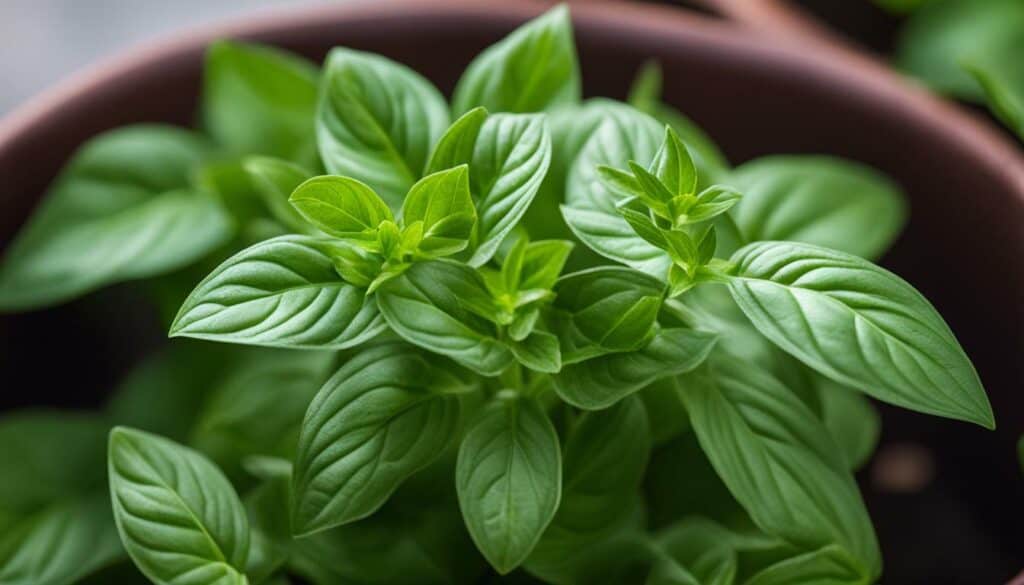
Known for its sweet and spicy flavor, cinnamon basil is a versatile herb that adds an interesting twist to a variety of dishes. Its fragrance and taste are reminiscent of cinnamon, making it a unique addition to both sweet and savory recipes.
With its compact and bushy growth habit, cinnamon basil is perfect for containers and flower beds. It adds visual appeal to any garden with its vibrant purple flowers that attract pollinators.
If you’re looking to grow cinnamon basil in your garden, start by sowing the seeds in well-worked, fertile soil in a sunny spot. Plant the seeds about 1/4 inch deep and keep the seed bed moist. Germination typically takes 1 to 2 weeks.
Once the seedlings are well-established, thin or transplant them to give them enough space to mature. Cinnamon basil plants can reach a height of 12 to 18 inches with a similar spread.
When it comes to harvesting cinnamon basil, pinch off the leaves from the top of the stems to encourage the plant to branch and produce more foliage. The fresh leaves can be used immediately in your favorite recipes, or you can preserve their flavor by drying, freezing, or incorporating them into infused oils and vinegars.
| Plant Height | Spread | Flavor | Uses |
|---|---|---|---|
| 12-18 inches | 12-18 inches | Sweet and spicy | Baked goods, jellies, vinegars |
Whether you’re a beginner or an experienced gardener, cinnamon basil is a great choice for adding a touch of sweetness to your herb garden. Its unique flavor and ornamental qualities make it a standout plant that will not only enhance your culinary creations but also bring beauty to your outdoor space.
Did you know? Cinnamon basil was brought to market by Ferry-Morse in the 1950s and was a winner of the All-America Selections Award in the flower category in 1962.
Dark Opal Basil: A Feast for the Senses
Dark Opal basil is not only a treat for the taste buds but also a feast for the eyes, with its stunning deep purple foliage and delicate flowers. This variety of basil, also known as Ocimum basilicum ‘Purpurascens’, adds a touch of elegance and beauty to any garden or container.
The leaves of Dark Opal basil have a rich, deep purple color that is truly captivating. Whether planted alongside other herbs or used as a standalone ornamental plant, it adds a vibrant splash of color to any setting. The distinctive hue of Dark Opal basil is due to the presence of anthocyanins, which are natural pigments responsible for the purple coloration.
Not only is Dark Opal basil visually stunning, but it also offers a unique anise-based flavor with a hint of ginger. This makes it a versatile herb that can be used in both sweet and savory dishes. Add it to your favorite salads, pasta dishes, cocktails, or even desserts for a burst of flavor.
Dark Opal basil is easy to grow and can be enjoyed all season long. It thrives in full sun and well-draining soil. Start the seeds indoors and transplant the seedlings outdoors after the danger of frost has passed. Regular pruning will help the plant maintain its bushy shape and encourage new growth.
Whether you’re an avid gardener or a beginner, Dark Opal basil is a great addition to any herb garden. Its striking appearance and unique flavor make it a favorite among culinary enthusiasts and gardeners alike. So why not add some excitement to your garden with Dark Opal basil?

Dark Opal Basil at a Glance:
| Botanical Name | Ocimum basilicum ‘Purpurascens’ |
|---|---|
| Flavor | Anise-based with a hint of ginger |
| Height | Average height of 14 inches |
| Spread | Compact, bushy form |
| Best Uses | Savory and sweet dishes, ornamental purposes |
Dark Opal basil adds a touch of elegance and beauty to any garden or container.
- Visually stunning with deep purple foliage
- Anise-based flavor with a hint of ginger
- Easy to grow and maintain
- Versatile use in a variety of dishes
- Compact size makes it suitable for containers
So why not indulge your senses with Dark Opal basil? Its unique color, flavor, and versatility make it a must-have addition to any garden or herb collection.
If you’re looking for a basil variety that combines excellent flavor and a bountiful harvest, Emerald Towers basil is the perfect choice with its tall, multi-branched growth habit.
Emerald Towers basil is a Genovese type that stands out for its unique growth pattern. It grows tall and upright, reaching a mature height of 24-36 inches with a spread of 8-12 inches. This columnar habit makes it a space-saving option for both garden beds and containers.
Not only does Emerald Towers basil offer a compact growth habit, but it also delivers exceptional flavor. It has a full licorice taste with a hint of spicy cloves, which adds a delightful twist to any dish. Whether you’re making pesto, pasta sauces, or soups, this basil variety will enhance the flavors of your culinary creations.
Another notable feature of Emerald Towers basil is its outstanding harvest yield. With its multi-branched growth habit, it produces a generous amount of leaves for prolonged harvesting. You’ll have an abundant supply of fresh basil throughout the growing season, allowing you to enjoy its aromatic and flavorful leaves in various dishes.
To grow Emerald Towers basil, choose a sunny location in your garden or a container with well-drained, fertile soil. This basil variety thrives in warm weather, so make sure to plant it after the last spring frost. Space the plants according to the label recommendations, usually 12-18 inches apart, to give them room to grow and develop their full potential.
Keep the soil consistently moist, watering deeply whenever the top inch becomes dry. Remember to pinch off the topmost branches of the basil plants when they reach 4-6 inches tall. This practice promotes more side shoots and encourages a taller overall plant. Regularly feed Emerald Towers basil with a water-soluble plant food to ensure optimal growth and leaf production.
With Emerald Towers basil in your garden, you’ll have a reliable source of flavorful and aromatic leaves that can elevate your culinary creations to new heights. Whether you’re a seasoned herb gardener or just starting out, this basil variety is a must-have for any kitchen garden.
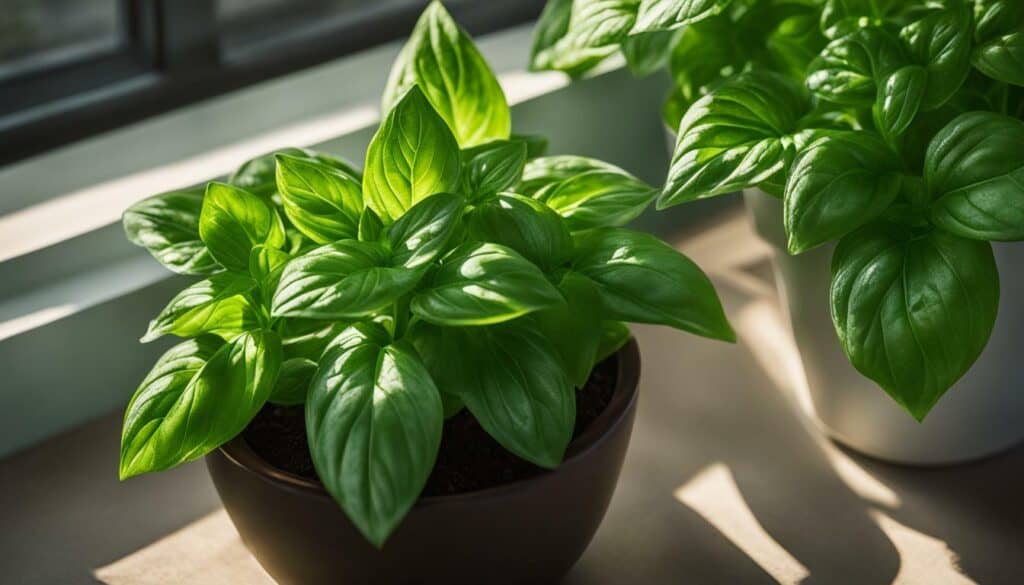
Genovese Basil: Elevate Your Dishes with Robust Flavor and Aromatic Leaves
Genovese basil, the traditional Italian heirloom variety, is a staple in many kitchens due to its robust flavor and ability to elevate any dish with its aromatic leaves. This iconic basil cultivar is highly valued for its versatility and culinary excellence.
“The bold and distinctive flavor of Genovese basil adds depth and complexity to a wide range of dishes. From classic Italian pasta sauces to refreshing summer salads, this herb is a must-have for any herb garden.”
Known for its large, lustrous leaves, Genovese basil is a member of the Ocimum basilicum species. It features a pronounced anise flavor and a sweet clove fragrance that enhances the overall taste profile of dishes. Whether used fresh or dried, Genovese basil leaves contribute a delightful aroma and a burst of flavor to numerous culinary creations.
One of the key characteristics of Genovese basil is its ability to pair well with other herbs and ingredients. It complements a wide range of flavors and can be used in various recipes, from traditional Italian pesto and Caprese salads to soups, sauces, and marinades. The versatility of Genovese basil makes it a favorite among both amateur and professional chefs.
Growing Genovese Basil
Genovese basil is relatively easy to grow and can be cultivated in both outdoor gardens and indoor containers. It thrives in warm weather and requires at least 6 to 8 hours of direct sunlight daily. When planting Genovese basil outdoors, make sure to choose a well-drained location with fertile soil.
Start by sowing Genovese basil seeds 2 weeks after the last spring frost. Space the seeds according to the label recommendations, typically around 12 to 18 inches apart. Keep the soil consistently moist but not waterlogged, as basil prefers slightly moist conditions. Regular watering and occasional feeding with a water-soluble plant food will help promote healthy growth and abundant foliage.
| Planting Information: | Genovese Basil |
|---|---|
| Sunlight: | 6-8 hours of direct sunlight daily |
| Spacing: | 12-18 inches apart |
| Soil: | Well-drained, fertile soil |
| Watering: | Consistently moist, not waterlogged |
| Feeding: | Regular watering and occasional feeding with water-soluble plant food |
Once your Genovese basil plants reach a height of 6 to 8 inches, you can start harvesting the leaves. Pinch off the leaves from the tips of the stems to encourage branching and more leaf production. Regular harvesting will also prevent the plant from flowering and going to seed too soon.
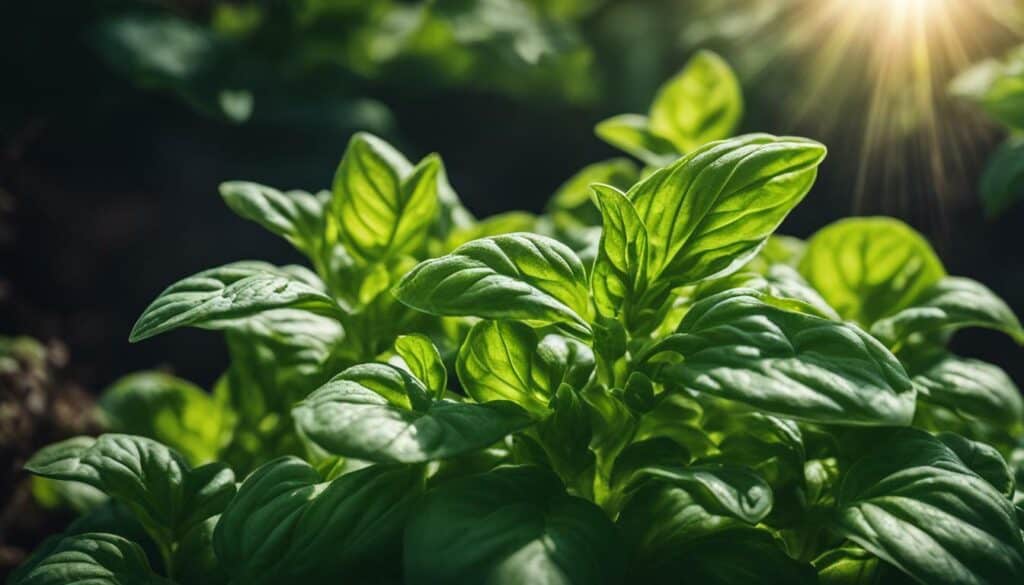
Genovese basil is best used fresh, but it can also be dried or frozen for later use. To preserve its flavor, avoid cooking it for an extended period and add it to dishes towards the end of the cooking process.
With its robust flavor and aromatic leaves, Genovese basil is a true gem in any culinary garden. Whether you’re making a classic Italian pasta dish or experimenting with new recipes, this traditional basil variety will undoubtedly enhance the overall taste and fragrance of your creations.
Greek Basil: Burst of Flavor for Mediterranean Dishes
Greek basil, with its compact growth habit and spicy fragrance, is a perfect choice for adding a burst of flavor to your favorite Mediterranean dishes. This variety of basil, scientifically known as Ocimum basilicum var. minimum, features small leaves, tiny white flowers, and a neat globular growth habit, making it an attractive addition to your herb garden or containers.
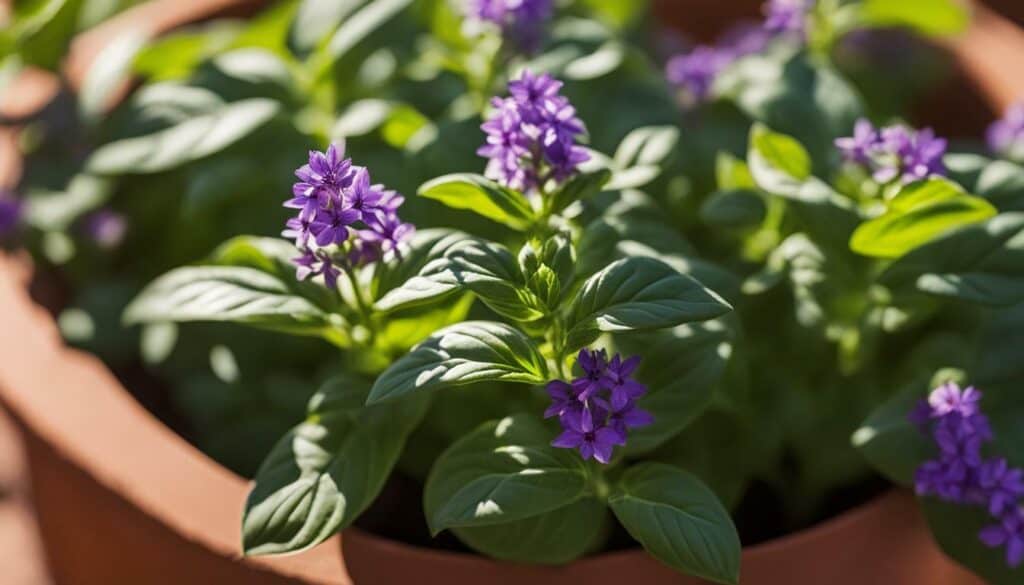
With its deeply spicy fragrance and strong flavor, Greek basil is best used in salad dressings, sauces, soups, and stews. Its compact size makes it ideal for container gardens, edging, or rockeries.
When growing Greek basil, make sure to provide it with 6 to 8 hours of sun, although it can benefit from afternoon shade in warmer regions. Plant it in well-drained, fertile soil with a pH of 6.0 to 7.0 for optimal growth.
Here are some key details about Greek basil:
| Growth Habit | Compact, globular |
|---|---|
| Flavor | Spicy, aromatic |
| Recommended Uses | Salad dressings, sauces, soups, and stews |
| Height | Approximately 8 inches |
To grow Greek basil, sow the seeds 1 inch apart in well-worked, fertile soil in full sun. Cover the seeds with 1/4 inch of soil, firm it gently, and keep the seed bed moist. Germination typically takes 7 to 14 days. Once the seedlings are well-established, thin them or transplant them 8 inches apart to allow room for mature growth.
Remember to pinch off the blooms to promote leaf production and prevent the plant from going to seed. Harvest the leaves by pinching them off the stems when the plants reach a height of 6 to 8 inches. Greek basil can be used fresh in various dishes, or you can dry or freeze the leaves for later use.
Cultivating Greek basil in your garden will not only provide you with a burst of flavor for your Mediterranean dishes but also add visual appeal with its neat and compact form. Enjoy the spicy fragrance and delicious taste of Greek basil in your culinary creations!
Italian Large Leaf Basil
Italian Large Leaf basil is a favorite among gardeners for its impressive size and mild flavor, making it ideal for creating delicious pesto and adding a fresh taste to salads and sauces. This variety of basil, also known as Ocimum basilicum, is known for its large, lustrous leaves that can grow up to 4 inches long. The leaves have a sweet and mild flavor, with hints of anise and clove.
Growing Italian Large Leaf basil is relatively easy. It thrives in well-drained soil with a pH of 6.0 to 7.0 and requires 6 to 8 hours of sunlight per day. It can be started from seeds indoors, 4 to 6 weeks before the last expected frost, or directly sown into the garden after the danger of frost has passed.
To sow Italian Large Leaf basil seeds indoors, plant them 1 inch apart in seed starting mix. Keep the soil warm and moist, and provide a good light source. When the seedlings are large enough to handle and nights reach 50°F (10°C), acclimate them gradually to outdoor conditions before transplanting them into the garden.
If sowing the seeds directly into the garden, prepare the soil by adding aged compost or organic matter to improve its fertility. Space the seeds according to the label recommendations, usually 12 to 18 inches apart. Cover the seeds with 1/4 inch of soil, firm it down, and keep the seed bed moist. Germination typically takes 7 to 14 days.
Once the Italian Large Leaf basil plants reach a height of 6 to 8 inches, you can start harvesting the leaves. Pinch off the leaves from the tips of the stems to encourage the plant to branch and produce more leaves. To extend the harvesting period, be sure to pinch off any flower buds that appear.
Italian Large Leaf basil is a versatile herb that can be used in a variety of culinary dishes. Its large leaves make it perfect for making pesto, a classic Italian sauce made with basil, garlic, pine nuts, Parmesan cheese, and olive oil. It can also be chopped and added to salads, sauces, soups, and stews for a fresh and aromatic flavor.
In addition to its culinary uses, Italian Large Leaf basil also has some medicinal properties. It is known for its antioxidant and anti-inflammatory properties, and it has been used in traditional medicine to treat digestive issues, headaches, and skin conditions.
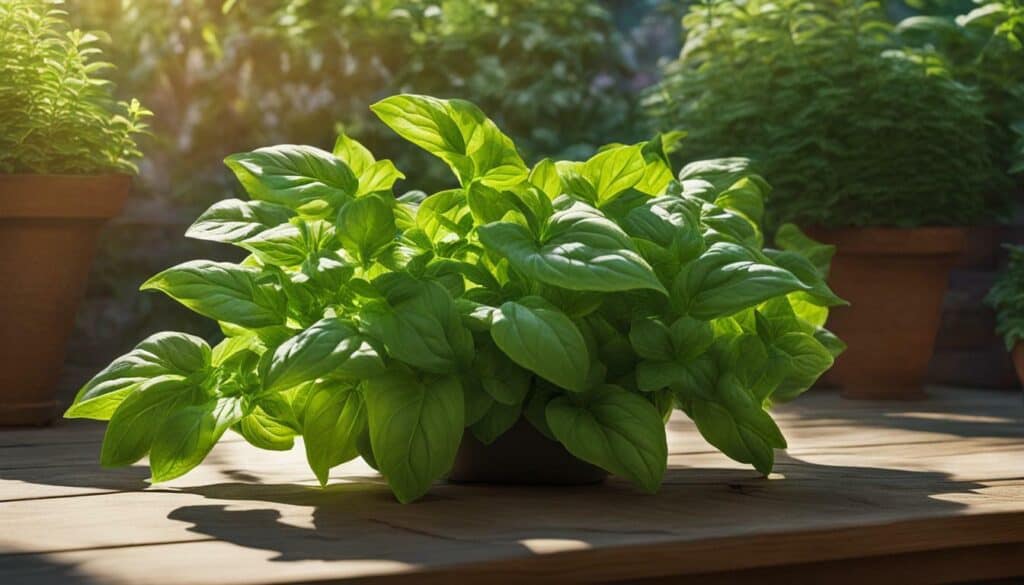
Overall, Italian Large Leaf basil is a must-have herb for any garden. Its impressive size, mild flavor, and versatility in the kitchen make it a favorite among gardeners and cooks alike. Whether you’re making pesto, adding fresh basil to your favorite dishes, or simply enjoying the aroma of this beautiful herb in your garden, Italian Large Leaf basil is sure to enhance your culinary experience.
Lemon Basil: A Refreshing Twist for Your Herb Garden
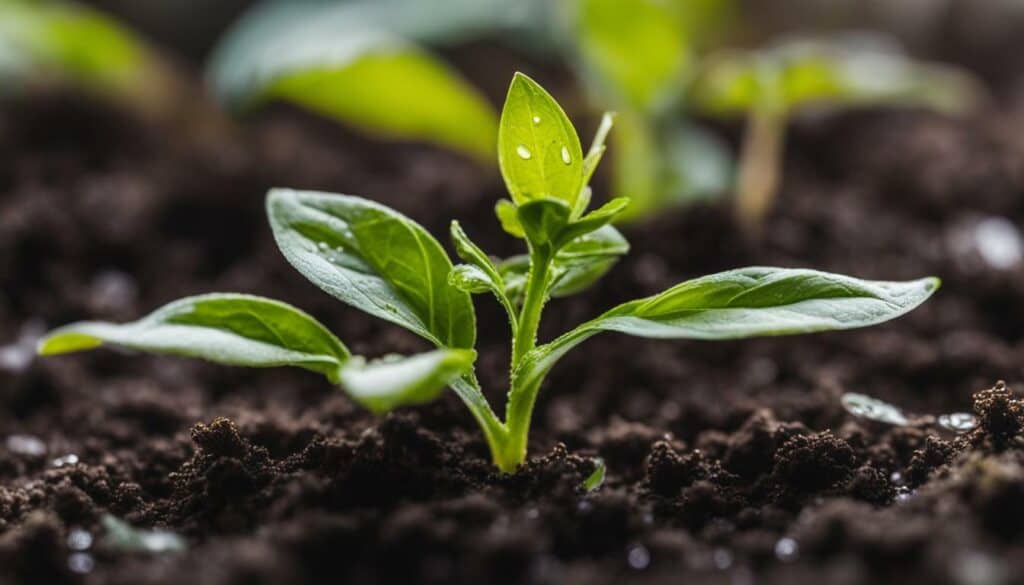
Lemon basil, with its tangy lemon scent and sweet-tart flavor, adds a refreshing twist to a variety of dishes, making it a must-have herb in your garden. This versatile herb is known for its unique citrus flavor and is perfect for incorporating into salads, wraps, curries, and other culinary creations.
Growing Lemon Basil
Lemon basil thrives in warm weather and requires at least 6 to 8 hours of sunlight per day. It can be grown directly in the garden or in containers. When planting in the garden, make sure to space the plants according to label recommendations, usually 12 to 18 inches apart. The soil should be well-drained and rich in organic matter, with a pH level between 6.0 and 7.0.
To start lemon basil from seeds, sow them 4 to 6 weeks before the last expected frost. Sow the seeds 1 inch apart in a seed starting mix and keep them warm and moist. Once the seedlings are large enough to handle and the nights reach 50°F (10°C), gradually acclimate them to outdoor conditions before transplanting them into the garden.
When the lemon basil plants reach a height of 6 to 8 inches, you can start harvesting the leaves by pinching them off. This will promote branching and encourage the plant to produce more leaves. Remember to harvest the leaves before the first prediction of frost, as the cold weather can quickly turn the leaves black.
Using Lemon Basil in the Kitchen
Lemon basil pairs perfectly with a wide range of dishes, adding a bright and zesty flavor. Its tangy lemon scent and sweet-tart taste make it an excellent addition to salads, dressings, and wraps. You can also incorporate lemon basil into curries, soups, stews, and stir-fries to add a refreshing twist to your favorite recipes.
To preserve the flavor of lemon basil, you can freeze the leaves or use them to make infused oils and vinegars. Simply place the leaves in a jar with oil or vinegar and let them infuse for a few weeks. This will create a delicious and aromatic ingredient that can be used to enhance the flavors of your dishes.
Benefits of Lemon Basil
- Lemon basil adds a unique citrus flavor to dishes
- It provides a refreshing twist to salads, dressings, and wraps
- The tangy lemon scent adds a delightful aroma to the kitchen
- Lemon basil is easy to grow and can be harvested throughout the summer
- It can be preserved and used in various culinary creations
As you can see, lemon basil is a versatile and flavorful herb that can elevate your dishes with its tangy lemon scent and sweet-tart flavor. Whether you’re growing it in your garden or using it in your kitchen, lemon basil is sure to add a refreshing twist to your culinary creations.
Growing basil from seeds provides a rewarding and flavorful experience for gardeners.
With so many cultivars to choose from, you can create a diverse and vibrant herb garden that adds fresh flavors to your culinary creations. Start your basil seed journey today and enjoy the lush greens and delicious aromas that this versatile herb has to offer.
Why Grow Basil from Seeds?
Growing basil from seeds has several advantages. Firstly, it is cost-effective as seeds are generally more affordable than buying nursery starts. Secondly, growing from seeds allows you to have control over the quality and health of your plants from the very beginning. Lastly, there is a certain satisfaction that comes from watching the seeds sprout and grow into thriving basil plants.
Choosing the Right Basil Seeds
When selecting basil seeds, it is important to choose reputable seed suppliers to ensure the quality and viability of the seeds. Consider the specific cultivars that best suit your taste preferences and growing conditions. Whether you prefer organic basil seeds or heirloom varieties, there are plenty of options available to suit your needs.
Popular Basil Cultivars for Your Garden
There is a wide variety of basil cultivars to choose from, each with its own unique flavor and characteristics. Some popular cultivars include Boxwood, Cinnamon, Dark Opal, Emerald Towers, Genovese, Greek, Italian Large Leaf, Lemon, Lime, Mammoth, Minette, Siam Queen, and Sweet basil. These cultivars offer a range of flavors and growth habits, giving you plenty of options to experiment within the kitchen.
Boxwood Basil
‘Boxwood’ is a compact basil variety with small leaves, making it perfect for containers and edging. It has a strong flavor that is superb in pesto.
Cinnamon Basil
‘Cinnamon’ basil has a unique sweet flavor reminiscent of cinnamon. Its narrow leaves, dark colored stems, and pretty purple flowers make it an attractive addition to your garden.
Dark Opal Basil
‘Dark Opal’ basil stands out with its deep purple leaves and pinky-lilac flowers. It has an anise-based flavor that can be used in both savory and sweet dishes.
Emerald Towers Basil
‘Emerald Towers’ is a tall Genovese type basil with a tidy columnar habit. It has a licorice taste and a scent of spicy cloves, making it a versatile herb for various culinary applications.
Genovese Basil
‘Genovese’ is a classic heirloom Italian basil with large, lustrous leaves and a pronounced anise flavor. It is perfect for making pesto, fresh salads, and savory dishes.
Greek Basil
Greek basil is a compact variety with small leaves and a deeply spicy fragrance. It is best used in salad dressings, sauces, soups, and stews.
Italian Large Leaf Basil
‘Italian Large Leaf’ basil has the largest leaves of all basil plants. It has a sweet and mild flavor, making it versatile for various culinary applications.
Lemon Basil
‘Lemon’ basil has a refreshing citrus flavor and is perfect for incorporating into salads, wraps, curries, and other culinary creations.
Explore these different basil cultivars and find the ones that suit your taste preferences and gardening needs. Whether you choose to grow them indoors or outdoors, basil seeds will bring life and flavorful aroma to your garden.
FAQ
Q: Why should I grow basil from seeds?
A: Growing basil from seeds allows you to have a cost-effective and high-quality supply of this flavorful herb. Plus, it’s satisfying to watch the seeds sprout and grow!
Q: How do I choose the right basil seeds?
A: When choosing basil seeds, it’s important to select from reputable seed suppliers and consider the specific cultivars that best suit your taste preferences and growing conditions.
Q: What are some popular basil cultivars to consider?
A: Some popular basil cultivars include Boxwood basil, Cinnamon basil, Dark Opal basil, Emerald Towers basil, Genovese basil, Greek basil, Italian Large Leaf basil, Lemon basil, Lime basil, Mammoth basil, Minette basil, and Siam Queen basil.
Q: How do I grow basil from seeds?
A: To grow basil from seeds, sow them in well-worked, fertile soil in full sun. Keep the seed bed moist and thin or transplant the seedlings once they are well-established. Harvest the leaves by pinching them off as needed.
Q: How do I care for basil plants?
A: Basil plants thrive in moist soil, so water them deeply once the top inch becomes dry. Pinch off the topmost branches to promote more side shoots and a taller plant overall. Keep basil fed with a water-soluble plant food to encourage excellent leaf production.
What Other Plants Can I Grow in My Garden for a Lush and Vibrant Oasis?
Looking to transform your garden? Consider adding a variety of plants to create a lush garden oasis. From vibrant flowers like roses and dahlias to leafy greens such as ferns and hostas, there are endless options to choose from. Remember to research proper care and maintenance for each plant to ensure they thrive in your oasis. Explore gardening blogs and forums for more lush garden oasis tips and tricks.

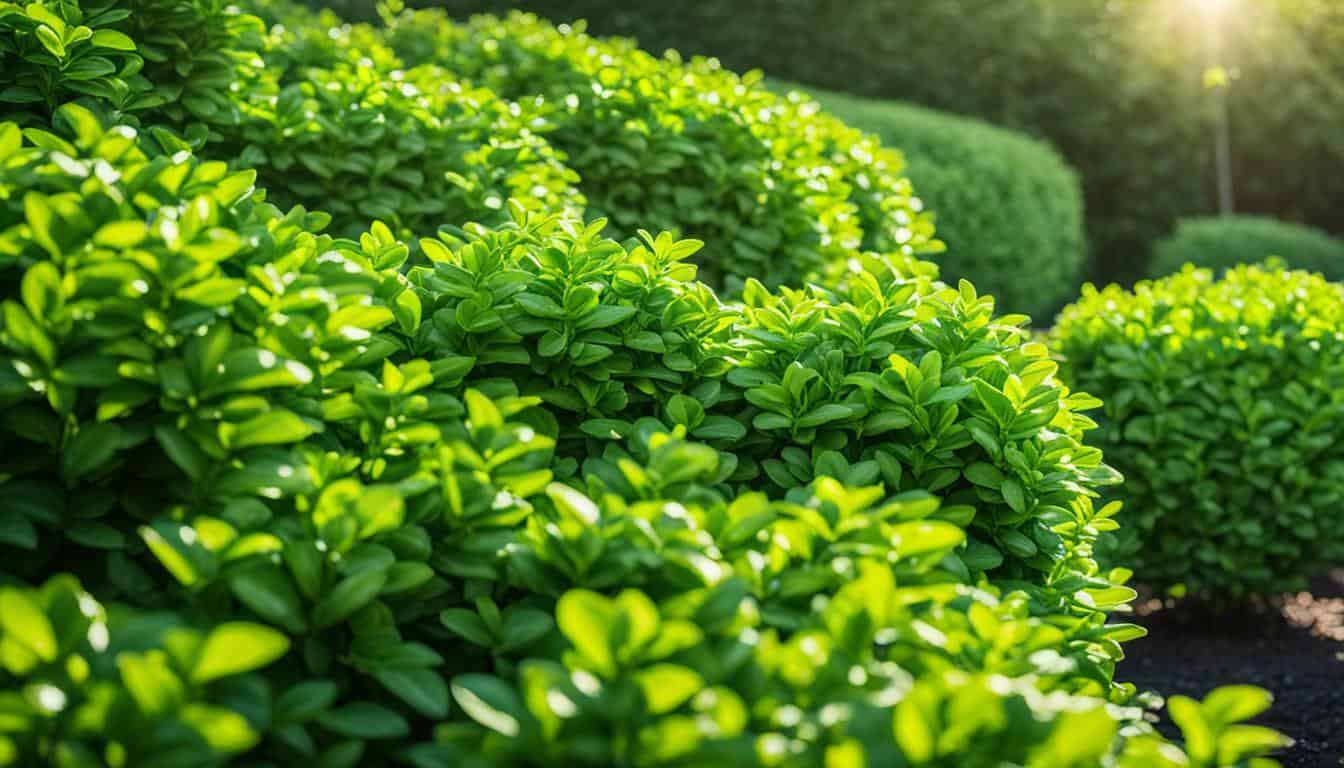



Leave a Reply